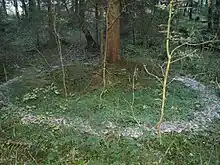Clitocybe nebularis
Clitocybe nebularis or Lepista nebularis, commonly known as the clouded agaric, cloudy clitocybe,[2] or cloud funnel, is an abundant gilled fungus which appears both in conifer-dominated forests and broad-leaved woodland in Europe and North America. Appearing in Britain from mid to late autumn, it is edible, but may cause gastrointestinal issues.
| Clitocybe nebularis | |
|---|---|
_tussen_afgevallen_beukenblad_(d.j.b.)_01.jpg.webp) | |
| Scientific classification | |
| Domain: | Eukaryota |
| Kingdom: | Fungi |
| Division: | Basidiomycota |
| Class: | Agaricomycetes |
| Order: | Agaricales |
| Family: | Tricholomataceae |
| Genus: | Clitocybe |
| Species: | C. nebularis |
| Binomial name | |
| Clitocybe nebularis | |
| Synonyms[1] | |
|
Agaricus nebularis Batsch (1789) | |
| Clitocybe nebularis | |
|---|---|
| Gills on hymenium | |
| Cap is convex or flat | |
| Hymenium is decurrent | |
| Stipe is bare | |
| Spore print is cream | |
| Ecology is saprotrophic | |
| Edibility is edible | |
Taxonomy
The species was first described and named as Agaricus nebularis in 1789 by August Johann Georg Karl Batsch. It was later placed in the genus Clitocybe in 1871 by Paul Kummer as Clitocybe nebularis. After much consideration by many mycologists, over some years, when it was placed for periods in both Lepista, and Gymnopus, it was placed back in Clitocybe with the specific epithet, and 1871 accreditation it retains today.
Clitocybe nebularis var. alba Bataille (1911), differs only in having a milk white cap, and is very rare.[3]
Description
The cap of the mushroom is 5–25 cm (2–8 in) in diameter, convex with an incurved margin, becoming plane to depressed in shape. Cap colours are generally greyish to light brownish-grey, and often covered in a whitish bloom when young. The surface of the cap is usually dry to moist, and radially fibrillose. The gills are pale, adnate to short-decurrent, close and usually forked.[4] The stem measures 5–10 cm (2–3+7⁄8 in) long and 2–4 cm wide;[5] it is stout, swollen towards the base, becomes hollow with age, and is easily broken. It is usually somewhat lighter than the cap.[3] The flesh is white, and very thick. It usually has a foul-smelling odour, which has been described as slightly farinaceous to rancid.[6][4]
The spores are yellow and elliptical.[5]
This species is host to the parasitic gilled mushroom Volvariella surrecta, which is found on older specimens.
Edibility
The species is edible but even a small portion can cause gastrointestinal disturbances for some people.[7]
Gallery
 The Pileus or cap
The Pileus or cap Detail of the gills
Detail of the gills The gills and cut stipe (stalk)
The gills and cut stipe (stalk) C. nebularis growing in a fairy ring formation
C. nebularis growing in a fairy ring formation_(d.j.b.)_02.jpg.webp) Close up of the top of a fully grown Clitocybe nebularis.
Close up of the top of a fully grown Clitocybe nebularis.
Similar species
The species may be confused with the poisonous Entoloma sinuatum both in Europe or North America, though this species has pink sinuate gills.[8] It also resembles Leucopaxillus albissimus and Tricholoma saponaceum.[5] Leucopaxillus giganteus is also similar in stature, but is whiter.[4] Infundibulicybe geotropa has a pale brown cap.[4]
References
- "Clitocybe nebularis (Batsch) P. Kumm. 1871". MycoBank. International Mycological Association. Retrieved 2011-10-26.
- Arora, David (1986). Mushrooms demystified: a comprehensive guide to the fleshy fungi (Second ed.). Berkeley: Ten Speed Press. ISBN 978-0-89815-169-5.
- "Rogers Mushrooms". Archived from the original on 2016-03-04. Retrieved 2011-11-17.
- Trudell, Steve; Ammirati, Joe (2009). Mushrooms of the Pacific Northwest. Timber Press Field Guides. Portland, OR: Timber Press. p. 93. ISBN 978-0-88192-935-5.
- Davis, R. Michael; Sommer, Robert; Menge, John A. (2012). Field Guide to Mushrooms of Western North America. Berkeley: University of California Press. pp. 150–151. ISBN 978-0-520-95360-4. OCLC 797915861.
- "California Fungi: Clitocybe nebularis". Retrieved 2008-01-11.
- Miller Jr., Orson K.; Miller, Hope H. (2006). North American Mushrooms: A Field Guide to Edible and Inedible Fungi. Guilford, CN: FalconGuide. p. 187. ISBN 978-0-7627-3109-1.
- Haas H (1969). The Young Specialist looks at Fungi. Burke. p. 128. ISBN 0-222-79409-7.